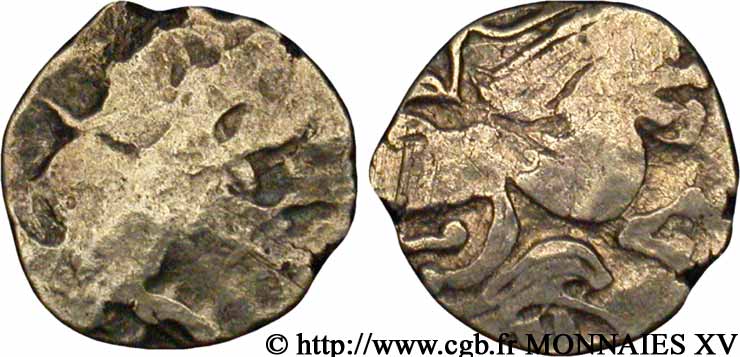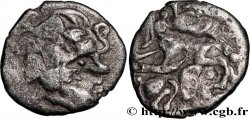v15_0757 - GALLIA - NAMNETES (Regione di Nantes) Quart de statère à l'hippophore
MONNAIES 15 (2002)
Prezzo di inizio : 120.00 €
Valutazione : 240.00 €
lotto invenduto
Prezzo di inizio : 120.00 €
Valutazione : 240.00 €
lotto invenduto
Tipo : Quart de statère à l'hippophore
Data: c. 60-50 AC.
Nome della officina / città: Nantes (44)
Metallo : elettro
Diametro : 13,5 mm
Asse di coniazione : 3 h.
Peso : 1,60 g.
Grado di rarità : R1
Commenti sullo stato di conservazione:
Monnaie complètement écrasée des deux côtés afin d’en faire disparaître les reliefs. Le revers se retrouve sur un flan légèrement bombé
N° nelle opere di riferimento :
Diritto
Titolatura diritto : ANÉPIGRAPHE.
Descrittivo diritto : Tête large et massive à droite, entourée de cordons perlés.
Rovescio
Titolatura rovescio : ANÉPIGRAPHE.
Descrittivo rovescio : Cheval androcéphale galopant à droite conduit par un aurige étendant la main droite ; entre les pattes du cheval, hippophore.
Commento
Ce type semble avoir été complètement usé artificiellement pour faire disparaître les motifs. Nous avons certainement affaire à un monnayage très tardif. La couleur jaune peut indiquer une présence d'or assez importante. L’appellation à l’hippophore vient du personnage qui est placé sous le cheval au revers (mot à mot celui qui porte le cheval où hippos se traduit par cheval et phoros par qui porte, en grec).
This type seems to have been completely artificially worn away to make the motifs disappear. We are certainly dealing with a very late coinage. The yellow color may indicate a fairly significant presence of gold. The name hippophora comes from the character placed under the horse on the reverse (literally the one who carries the horse where hippos translates as horse and phoros as who carries, in Greek)
This type seems to have been completely artificially worn away to make the motifs disappear. We are certainly dealing with a very late coinage. The yellow color may indicate a fairly significant presence of gold. The name hippophora comes from the character placed under the horse on the reverse (literally the one who carries the horse where hippos translates as horse and phoros as who carries, in Greek)








 Segnalare un errore
Segnalare un errore Stampate la pagina
Stampate la pagina Condividi mia selezione
Condividi mia selezione Fai una domanda
Fai una domanda Consegnare / vendere
Consegnare / vendere
 Descrittivo
Descrittivo









